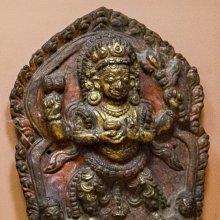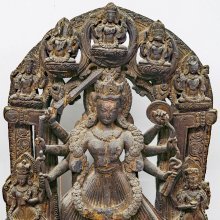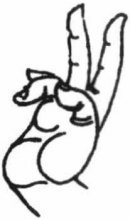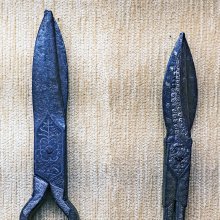Kartari, Kartarī: 13 definitions
Introduction:
Kartari means something in Buddhism, Pali, Hinduism, Sanskrit, Marathi. If you want to know the exact meaning, history, etymology or English translation of this term then check out the descriptions on this page. Add your comment or reference to a book if you want to contribute to this summary article.
Images (photo gallery)
In Hinduism
Natyashastra (theatrics and dramaturgy)
Source: Wisdom Library: Nāṭya-śāstraKartarī (कर्तरी) refers to one of the five characteristics of the hand (upahasta) according to the Nāṭyaśāstra chapter 33. Accordingly, “the movement of the forefinger and the thumb of the two hands by letting them fall one after another is called Kartarī”.

Natyashastra (नाट्यशास्त्र, nāṭyaśāstra) refers to both the ancient Indian tradition (shastra) of performing arts, (natya—theatrics, drama, dance, music), as well as the name of a Sanskrit work dealing with these subjects. It also teaches the rules for composing Dramatic plays (nataka), construction and performance of Theater, and Poetic works (kavya).
Shilpashastra (iconography)
Source: Shodhganga: The significance of the mūla-beras (śilpa)Kartari refers to “scissors”, representing one of the several “attributes” (āyudha) or “accessories” of a detiy commonly seen depicted in Hindu iconography, defined according to texts dealing with śilpa (arts and crafs), known as śilpaśāstras.—The śilpa texts have classified the various accessories under the broad heading of āyudha or karuvi (implement), including even flowers, animals, and musical instruments. Some of the work tools held in the hands of deities are, for example, Kartari.

Shilpashastra (शिल्पशास्त्र, śilpaśāstra) represents the ancient Indian science (shastra) of creative arts (shilpa) such as sculpture, iconography and painting. Closely related to Vastushastra (architecture), they often share the same literature.
Shaivism (Shaiva philosophy)
Source: Google Books: Manthanabhairavatantram (shaivism)1) Kartari (कर्तरि) (Cf. Pīṭha) refers to a “knife”, according to the Niḥśvāsatattvasaṃhitā, one of the most ancient of extant Śaiva Tantras.—Accordingly, “Having offered a seat (pīṭha), umbrella, turban and knife [i.e., kartari], (one should say): ‘You are the teacher, Śiva's equal; exercise (your) grace in the world’.”.
2) Kartarī (कर्तरी) refers to a “dagger” and represents one of the attributes of Svacchanda, according to the Śrīmatottara-tantra, an expansion of the Kubjikāmatatantra: the earliest popular and most authoritative Tantra of the Kubjikā cult. Accordingly, “O goddess, Svacchanda is in the middle, within the abode of the triangle. Very powerful, he has five faces with three times five flaming eyes. [...] O fair lady, my attributes—trident, dagger [i.e., kartarī], sword, the king of the snakes, and rosary—adorn the right (arms). O beloved, a skull, double-headed drum, javelin, noose and goad—(these) are my divine, brilliant and very auspicious weapons that (are held) in the left (hands). The king of snakes (hangs) on the shoulder and a garland of skulls hangs (from the neck). There is a necklace of scorpions around the throat and the ears are adorned with snakes. [...]”.
Source: SOAS University of London: Protective Rites in the Netra TantraKartari (कर्तरि) refers to “scissors”, according to the Netratantra of Kṣemarāja: a Śaiva text from the 9th century in which Śiva (Bhairava) teaches Pārvatī topics such as metaphysics, cosmology, and soteriology.—Accordingly, [verse 11.1-24ab, while describing the appearance and worship of Tumburu]—“[...] However, those who are Dūtīs bear a form adorned with one face, two arms, and three eyes. Adorning [them is] hair, shorn with scissors (muṇḍa-kartari-bhūṣitā). They sit on a fish, a turtle, a makara, and a frog. The servants are two-armed and hold a sword and a hide, [faces bent] in a crooked frown [on their] single faces, [which is adorned with] three eyes. [When] meditated on, [they] burst forth with white, etc., colors, giving the fruits of siddhis. [...]”.

Shaiva (शैव, śaiva) or Shaivism (śaivism) represents a tradition of Hinduism worshiping Shiva as the supreme being. Closely related to Shaktism, Shaiva literature includes a range of scriptures, including Tantras, while the root of this tradition may be traced back to the ancient Vedas.
Mantrashastra (the science of Mantras)
Source: Shodhganga: Kasyapa Samhita—Text on Visha Chikitsa (mantra)Kartarī (कर्तरी) refers to “mantras having two syllables”, and represents a particular classification of mantras (“that which is chanted by people to obtain their spiritual aspirations”), according to the Nityatantra (bhūmikā, p. 13. mantramahodadhi).—The Nitya Tantra asserts that a single-syllable mantra is known as piṇḍa, while two-syllable mantras are called kartarī. Mantras with three to nine syllables are called bīja. Those with 10 to 20 letters are called mantras. Mantras with more than 20 letters are called Mālā.
Mantrashastra (शिल्पशास्त्र, mantraśāstra) refers to the ancient Indian science of mantras—chants, incantations, spells, magical hymns, etc. Mantra Sastra literature includes many ancient books dealing with the methods reciting mantras, identifying and purifying its defects and the science behind uttering or chanting syllables.
In Buddhism
Tibetan Buddhism (Vajrayana or tantric Buddhism)
Source: Wisdomlib Libary: VajrayoginiKartarī (कर्तरी, “chopper”).—The chopper is especially associated with Vajrayoginī in the Guhyasamayasādhanamālā and symbolizes the “choppig off” of defilements. It is mentioned, for example, in the twenty-one-verse stotra (verse 42.8): “Homage to you, Vajrayoginī! You who hold a skull bowl and staff on your left and a chopper on your right; who hold empitness and compassion.”

Tibetan Buddhism includes schools such as Nyingma, Kadampa, Kagyu and Gelug. Their primary canon of literature is divided in two broad categories: The Kangyur, which consists of Buddha’s words, and the Tengyur, which includes commentaries from various sources. Esotericism and tantra techniques (vajrayāna) are collected indepently.
Languages of India and abroad
Marathi-English dictionary
Source: DDSA: The Aryabhusan school dictionary, Marathi-Englishkartarī (कर्तरी).—f Scissors.
Marathi is an Indo-European language having over 70 million native speakers people in (predominantly) Maharashtra India. Marathi, like many other Indo-Aryan languages, evolved from early forms of Prakrit, which itself is a subset of Sanskrit, one of the most ancient languages of the world.
Sanskrit dictionary
Source: DDSA: The practical Sanskrit-English dictionaryKartarī (कर्तरी).—
1) Scissors.
2) A knife.
3) Cutlass, small sword.
4) (kartarī) A kind of dance.
See also (synonyms): kartarikā.
Source: Cologne Digital Sanskrit Dictionaries: Cappeller Sanskrit-English DictionaryKartari (कर्तरि).—[feminine] scissors or some other cutting instrument.
--- OR ---
Kartarī (कर्तरी).—[feminine] the same; phala [neuter] blade of a knife.
Source: Cologne Digital Sanskrit Dictionaries: Monier-Williams Sanskrit-English Dictionary1) Kartari (कर्तरि):—[from karta] f. scissors, a knife, or any instrument for cutting, [Suśruta; Hemādri’s Caturvarga-cintāmaṇi]
2) Kartarī (कर्तरी):—[from karta] f. idem, [Hemādri’s Caturvarga-cintāmaṇi]
3) [v.s. ...] the part of an arrow to which the feathers are attached, [cf. Lexicographers, esp. such as amarasiṃha, halāyudha, hemacandra, etc.]
4) [v.s. ...] a kind of dance.
[Sanskrit to German]
Sanskrit, also spelled संस्कृतम् (saṃskṛtam), is an ancient language of India commonly seen as the grandmother of the Indo-European language family (even English!). Closely allied with Prakrit and Pali, Sanskrit is more exhaustive in both grammar and terms and has the most extensive collection of literature in the world, greatly surpassing its sister-languages Greek and Latin.
Kannada-English dictionary
Source: Alar: Kannada-English corpusKartari (ಕರ್ತರಿ):—
1) [noun] an instrument for cutting fabric, paper, hair, etc., having two pivoted blades with finger and thumb holes in the handles, operating by closing on the material to be cut; a pair of scissors.
2) [noun] a small sword-like weapon; a dagger.
3) [noun] the back feathered end of an arrow.
Kannada is a Dravidian language (as opposed to the Indo-European language family) mainly spoken in the southwestern region of India.
See also (Relevant definitions)
Starts with: Kartari Hasta, Kartari-svastika, Kartaribhushita, Kartaridhara, Kartarigalu, Kartarika, Kartarikamukha, Kartarimamdi, Kartarimukha, Kartarimukhahasta, Kartariphala, Kartariprayoga, Kartarisu, Kartariya.
Ends with: Balakartari, Mundakartari, Pattrakartari, Premapiyushalatakartari, Udvegakartari.
Full-text (+119): Kartarimukha, Kartarika, Karttrika, Kartariphala, Kartari-svastika, Dundupha, Kartaryasya, Hintala, Ambarisha, Kuruvaka, Shami, Pattrakartari, Premapiyushalatakartari, Vyatihara, Anudhyaya, Sankula, Udvegakartari, Admara, Bhartribhratri, Ancati.
Relevant text
Search found 22 books and stories containing Kartari, Kartarī; (plurals include: Kartaris, Kartarīs). You can also click to the full overview containing English textual excerpts. Below are direct links for the most relevant articles:
Rig Veda (translation and commentary) (by H. H. Wilson)
Rig Veda 1.139.7 < [Sukta 139]
Abhinaya-darpana (English) (by Ananda Coomaraswamy)
Chapter 25 - Hands denoting Trees
Chapter 28 - Hands denoting Water Creatures
Vakyapadiya of Bhartrihari (by K. A. Subramania Iyer)
Verse 2.455 < [Book 2 - Vākya-kāṇḍa]
Verse 2.454 < [Book 2 - Vākya-kāṇḍa]
Verse 3.7.95 < [Book 3 - Pada-kāṇḍa (7): Sādhana-samuddeśa (On the Means)]
Sahitya-kaumudi by Baladeva Vidyabhushana (by Gaurapada Dāsa)
Text 10.11 < [Chapter 10 - Ornaments of Meaning]
Text 10.10 < [Chapter 10 - Ornaments of Meaning]
Trishashti Shalaka Purusha Caritra (by Helen M. Johnson)
Thirty-six weapons < [Notes]
Manusmriti with the Commentary of Medhatithi (by Ganganatha Jha)
Verse 9.32 < [Section III - To whom does the Child belong?]



